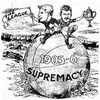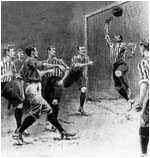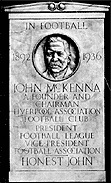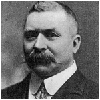
1892 – Liverpool Football Club
formed
 |
When the Football League was founded in 1888, Anfield was one of League's original grounds. On September 8th 1888 the very first Saturday of League football, Anfield welcomed as visitors Accrington to play not against the 'Reds', but the 'Blues' of Everton Football Club.The blue and white quartered shirts of Everton FC made quite a name for themselves at Anfield winning the League Championship in 1891, but this is to run ahead slightly. Both teams owe their existence to a Reverend Chambers of the then newly constructed and now, totally demolished, church - St Domingo, and to John Houlding - Tory MP and Mayor of Liverpool who ultimately caused Everton FC to leave Anfield and who created Liverpool Football Club. |
St Domingo's football team was a strictly amateur affair created amid the belief that young lads could better be kept on the path of religious well-being through a healthy passion for competitive team games. After only a year or so of enthusiastic play in Stanley Park, they renamed themselves Everton Football Club in honour of the location of their founding church.
The St Domingo's team met however not at Church, but the Queen's Head Hotel in Village Street adjacent to "Ye Anciente Everton Toffee House". From this Everton F.C. gained their curious nickname of "The Toffees". In adopting the name Everton, the team ensured that they would permanently struggle to be located with confidence by those from outside of the city and lead to Royalty asking "Tell me, from which part of the country is the city of Everton?" nearly a century later.
 |
The fledgling Everton played in a number of locations but settled in a greenfield site between Anfield Road and Walton Breck Road. So was born one of the great names in world football - Anfield. The team prospered and became financially sound with astute guidance from their President Mr John Houlding. John Houlding was a brewer, local council member and later Mayor of Liverpool. Despite this he has become a largely forgotten figure in the city, although a bronze plaque outside the Directors' Lounge in Anfield and a fine oil portrait hanging within the Club museum preserve his likeness. |
For a man responsible for the development of Everton and the creation of Liverpool Football Club, it is amazing how little he is remembered. There are however a few landmarks in the area where Houlding was known as "King John of Everton". The very short 'Houlding Street' has on it's corner the 'Sandon' pub. This pub was once owned by Houlding and he led many meetings of Everton Football Club from here in the bowls pavilion that existed to the rear. The place was also used as a dressing room by the players for many years. Both Everton and later Liverpool football teams were first photographed in front of this bowls pavilion.
It can be questioned whether Everton would have been one of the founding members of the Football League in 1888 without Houlding's assistance. He brought Everton to Anfield in 1884. They previously rented a little field in Priory Road, north of Stanley Park, but they were unwelcome because of the noisy crowds on match days.
So Houlding went to his friend and fellow
brewer, Mr. Orrell, who owned a place in Anfield Road and conducted the
business to get a new home ground. But it was from this point on that
criticism of the club President started to grow from some members of the
Everton board, building up to a crisis in 1892.
It was not the rent alone that annoyed the board members. Houlding also
wanted only his sparkling ales to be sold at the ground, and he of course
profited very considerably from this arrangement. However it was still
John Houlding that helped the club out when they need money to buy players
and rebuild the ground.
The Sandon's use as dressing room was an
arrangement that really only suited Houlding as he again benefited from
his players drinking his products. A letter in the Liverpool Echo in
January 1892 suggested that Houlding didn't want the club to move out of
the pub.
The writer says: "It's a disgrace that at a big club such as Everton,
players have to walk through hordes of people on match days."
The conflict on how the club should be managed and conduct its business came to a to a head in 1889-90. The rent at Anfield went up again. Everton FC paid £100 in 1884. By 1889-90 Houlding was charging them £250. Houlding had many practical and realistic solutions on how they could solve this situation. One was to transform Everton into a plc. On the 15th of September 1891 he chaired a meeting about the issue.
The local press was banned as he predicted trouble ahead. And trouble it was. Houlding suggested that Everton FC should buy Anfield and also some land he owned adjoining the ground. The price seemed high and the members said no. Although with the growing development of football and the club, the land would soon have paid for itself.
In October the same year, the on-going deadlock over this situation resulted in the vast majority of the Board and players of Everton F.C. walking out to build a new ground. Houlding explained why this situation arose in a match programme against Cliftonville in April 1893. He pointed out that he had given Everton a rent free loan until the club started to make money. If the club had gone bust he would have lost it all.
Despite making no profit in this respect, the issue that upset the members at Everton most was his plan to sell Anfield and the land adjoining, with Houlding himself profiting. He felt it was a reasonable reward for the risk he had ventured in the club for nine years. Houlding, as the ambitious businessman he was, saw a great future for the club. He wanted the club to have its own home ground and wanted them to buy land so the club could expand in due course.
Unfortunately most of the Everton FC board members failed to share his forward thinking and lacked confidence. They wanted instead a long term rent deal on all the land, but for this to be acceptable to Houlding, he wanted a rent at a price considered too high for the Club. The members reacted to that by "offering" Houlding less rent. Houlding unsurprisingly refused to accept this stating that he did not want to be dictated: "I cannot understand why a gentleman that has done so much for the club (Everton) and its members should be given such treatment".
 |
The official split between Houlding and Everton
took place on the 12th of March 1892. At a members meeting one of
the opponents George Mahon, led the meeting when John Houlding
unexpectedly turned up. Mahon stood up to give the club's
President the chair. But surrounded by "enemies" Mr.
Houlding said the famous words: "I'm here on a trial, and a
criminal never takes the chair". He then left the club with
18-19 other members. Barclay had been the first secretary at Everton when they became a league club in 1888, and so in turn became the first secretary at Liverpool. Bearing in mind Barclay's suggestion, it was surprising that on 26th of January 1892 Houlding tried to form a 'new' Everton: The "Everton Football Club and Athletic Grounds Company plc" was registered in London on that date and as the 'old' Everton club was not registered as a plc Houlding had hoped to perform a weird "takeover" of Everton; stealing the name of the club in a legal way. But a meeting at the Football Council on 4th of February 1892 ruled that it could not approve membership of a new club with the same name as an existing member! |
At the same time a group of Everton patriots, among them the organist from the St. Domingo's church, had made a deal to buy a piece of land north of Stanley Park. The land cost them £8,090. Four members paid £1,000 each to let the deal go through. Houlding, left with an empty ground, took the bold step of forming a new football team to play in it.
Unable keep the Everton F.C. name he then thought bigger and finally acceded to his secretary's proposal, and named his club after the entire city rather than one of its suburbs, even adopting by 1894 the City's colour of red for the playing shirts and by 1901 the Liverbird as the crest.
 |
The majority of Everton's backroom and playing staff left for Goodison, so Liverpool FC had to be built from scratch. Fortunately one John McKenna stayed loyal to Houlding along with Barclay the Secretary. Most of the team building work was carried out by McKenna, a dynamic and personable Irishman. 'Honest' John McKenna did more than most people in English football. |
He was to be a director at Anfield for 30 years, and also served the club as chairman on two occasions. He was a member of the FA Council from 1905, and he became the President of the Football League in 1910, and Vice-President of the Football Association in 1928. He also served on many different committees until he died in 1936. He was a well respected man, with an unique know-how of the game. Houlding is the founder of the club, but McKenna was the man and the brain behind early successes.
His rapid elevation to the top of English football is proof of John McKenna's abilities as a manager and administrator. With a generous loan from Houlding of £500 that was never paid back, and McKenna's know how, over a dozen players were recruited from Scotland. This led to LFC becoming known as the "Team of all the Macs" because of their surnames. However amongst the Scottish "Macs" in the early formations the goalkeeper Bill McOwen was in fact an Englishman.
Liverpool's initial application to join the Football League was rejected and so they began life in the Lancashire League. On the first of September 1892 Liverpool AFC played their first match at Anfield. The opponents were Rotherham from the Midland League in a friendly.
On the very same day Everton played their first match at Goodison on the other side of Stanley Park. The rivalry was on! Which team would the people of Liverpool support? The Liverpool directors announced to the newspapers that: "No better game will be witnessed on any of the plots in the neighbourhood". That was their message to Everton. The papers write that 'Councillor J. Houlding kicked off the match'. Liverpool won the match 7-1. McVean scored the first ever Liverpool goal early in the first half. The only disappointment on the day was that only a handful people turned up. More than 10,000 came to Goodison.
A couple of days later Liverpool played the first match in the Lancashire League. Again LFC won heavily by eight goals to nil. The match was postponed for a few hours because of a late arrival of the guest team. Again only a few hundred people witnessed this convincing win. The captain of the day, McVean, won the toss and chose to play towards Anfield Road in the first half. A tradition many Liverpool captains have followed to this day. The club's first competitive match was at home to Higher Walton on September 3rd 1892 with Liverpool yet again winning 8-0.
On 3 September 1892 Higher Walton were the
opposition for the club's first competitive match and the occasion was
marked by another 8-0 success.
It was the start of an excellent season and Liverpool easily took the
League as well as the Liverpool District Cup. With a reserve cup secured
as well Liverpool had claimed a modest 'treble'. Highly impressive for a
team not even 12 months old. Everton were getting worried.